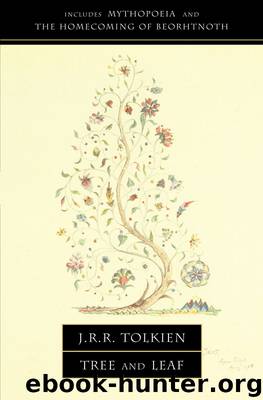Tree and Leaf by J. R. R. Tolkien

Author:J. R. R. Tolkien [J.R.R. Tolkien]
Language: eng
Format: epub
Publisher: HarperCollins Publishers
Published: 2012-07-31T16:00:00+00:00
NOTES
A (see here)
The very root (not only the use) of their ‘marvels’ is satiric, a mockery of unreason; and the ‘dream’ element is not a mere machinery of introduction and ending, but inherent in the action and transitions. These things children can perceive and appreciate, if left to themselves. But to many, as it was to me, Alice is presented as a fairy-story and while this misunderstanding lasts, the distaste for the dream-machinery is felt. There is no suggestion of dream in The Wind in the Willows. ‘The Mole had been working very hard all the morning, spring-cleaning his little house.’ So it begins, and that correct tone is maintained. It is all the more remarkable that A. A. Milne, so great an admirer of this excellent book, should have prefaced to his dramatised version a ‘whimsical’ opening in which a child is seen telephoning with a daffodil. Or perhaps it is not very remarkable, for a perceptive admirer (as distinct from a great admirer) of the book would never have attempted to dramatise it. Naturally only the simpler ingredients, the pantomime, and the satiric beast-fable elements, are capable of presentation in this form. The play is, on the lower level of drama, tolerably good fun, especially for those who have not read the book; but some children that I took to see Toad of Toad Hall brought away as their chief memory nausea at the opening. For the rest they preferred their recollections of the book.
B (see here)
Of course, these details, as a rule, got into the tales, even in the days when they were real practices, because they had a story-making value. If I were to write a story in which it happened that a man was hanged, that might show in later ages, if the story survived – in itself a sign that the story possessed some permanent, and more than local or temporary, value – that it was written at a period when men were really hanged, as a legal practice. Might: the inference would not, of course, in that future time be certain. For certainty on that point the future inquirer would have to know definitely when hanging was practised and when I lived. I could have borrowed the incident from other times and places, from other stories; I could simply have invented it. But even if this inference happened to be correct, the hanging-scene would only occur in the story, (a) because I was aware of the dramatic, tragic, or macabre force of this incident in my tale, and (b) because those who handed it down felt this force enough to make them keep the incident in. Distance of time, sheer antiquity and alien-ness, might later sharpen the edge of the tragedy or the horror; but the edge must be there even for the elvish hone of antiquity to whet it. The least useful question, therefore, for literary critics at any rate, to ask or to answer about Iphigeneia, daughter of Agamemnon, is: Does
Download
This site does not store any files on its server. We only index and link to content provided by other sites. Please contact the content providers to delete copyright contents if any and email us, we'll remove relevant links or contents immediately.
Aircraft Design of WWII: A Sketchbook by Lockheed Aircraft Corporation(32215)
The Great Music City by Andrea Baker(31357)
Call Me by Your Name by André Aciman(20373)
The Secret History by Donna Tartt(18849)
The Art of Boudoir Photography: How to Create Stunning Photographs of Women by Christa Meola(18537)
Shoot Sexy by Ryan Armbrust(17659)
Plagued by Fire by Paul Hendrickson(17331)
Portrait Mastery in Black & White: Learn the Signature Style of a Legendary Photographer by Tim Kelly(16953)
Adobe Camera Raw For Digital Photographers Only by Rob Sheppard(16904)
Photographically Speaking: A Deeper Look at Creating Stronger Images (Eva Spring's Library) by David duChemin(16623)
Ready Player One by Cline Ernest(14525)
Pimp by Iceberg Slim(14394)
Bombshells: Glamour Girls of a Lifetime by Sullivan Steve(13975)
The Goal (Off-Campus #4) by Elle Kennedy(13543)
Art Nude Photography Explained: How to Photograph and Understand Great Art Nude Images by Simon Walden(12975)
Kathy Andrews Collection by Kathy Andrews(11730)
The Priory of the Orange Tree by Samantha Shannon(8891)
The remains of the day by Kazuo Ishiguro(8822)
Thirteen Reasons Why by Jay Asher(8796)
